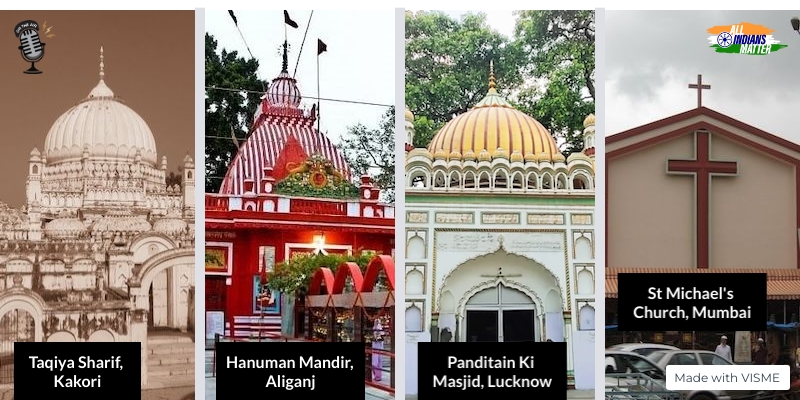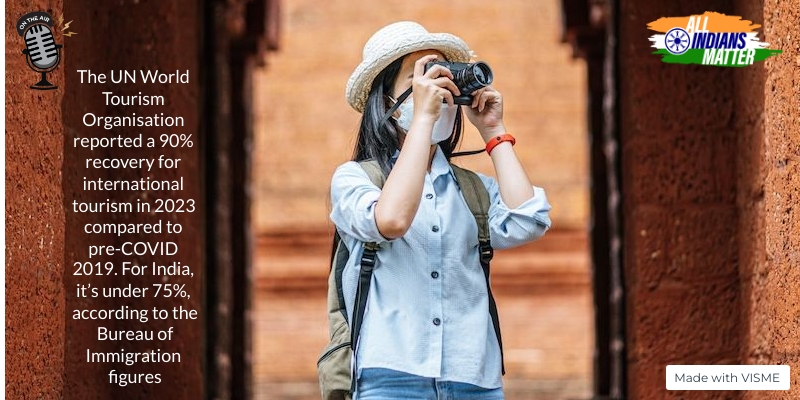Ashraf Engineer
February 10, 2024
EPISODE TRANSCRIPT
Hello and welcome to All Indians Matter. I am Ashraf Engineer.
In the tiny town of Kakori in Uttar Pradesh’s Lucknow district lies the two and a half centuries old Taqiya Sharif shrine, the epitome of India’s syncretic culture. Among the devotees you will find Muslims, women in ghunghat sporting sindoor and others distributing prasad during Hindu festivals. Sufi saint Shah Muhammad Qasim Qalandar, who is buried there, revered Lord Krishna and claimed to have had visions of him. And the communal harmony in the region is attributed to Qasim Qalandar.
On the urs, or death anniversary of the saint, a Hindu family lights candles all over the complex. The chief administrator of the shrine recites a verse of the Quran on Diwali and asserts that brotherhood among communities will never be extinguished in small towns.
Today, as yet another mosque, the Gyanvapi Masjid, is being sought to be taken over by Hindu supremacists, it’s worth remembering the example of syncretism set by Lucknow through the centuries. Several temples there as well as in Ayodhya were built by Muslims or maintained by Muslim rulers. Similarly, there are mosques and imambaras built by Hindus. It was Awadhi Nawab Asaf-ud-Daula’s mother, Aliya Begum, who built Lucknow’s famous Hanuman mandir in the Aliganj locality. The old dome still sports a moon and a star as a mark of her role in constructing the temple. This, incidentally, is the biggest and oldest Hanuman temple in Lucknow and 30,000 visit it on Tuesdays and Saturdays.
Legend has it that Lord Hanuman appeared to Aliya Begum in a dream, telling her that he could be found buried in a garden and that he would like her to have him extricated. Aliya Begum identified the spot, ordered an excavation, a Hanuman idol was found and installed in the temple she built.
In another example of Indian syncretism found in Lucknow, Nawab Wajid Ali Shah wrote the famous Urdu play Radha-Kanhaiya in which he himself played Krishna.
In Aminabad locality of Lucknow is the ‘Panditain ki Masjid’ or the Brahmin Woman’s Mosque. As the name suggests, it was built by a Brahmin woman for Muslims of the area.
Why am I citing all these examples? It’s because last week I spoke about Indian syncretism through the lens of Urdu poetry and the large body of work of Muslim poets writing in Urdu on Hindu epics. I wanted to follow that up with a broader perspective of syncretism and how it manifests itself in India.
SIGNATURE TUNE
Syncretism is the result of many diverse religions and forms of worship coexisting in a single place, influencing and shaping each other. Sometimes, even new belief systems can emerge from this. Of course, in today’s age of easy migration and great exposure of cultures to each other, syncretic processes are amplified and accelerated.
People like me celebrate this, but there are many who view it in a negative light. They consider syncretic traditions to be impure, polluted by local ideas and practices. Among the positive connotations could be the resistance to any sort of cultural dominance.
In India, particularly, religious syncretism is often expressed through the term ‘unity in diversity’. This is because India is a confluence of traditions, beliefs and languages. Hinduism, the dominant religion, is itself heterogeneous. Even within it, there is a diversity of traditions and practices. And India is the birthplace of other religions such as Buddhism, Jainism and Sikhism. Religions from elsewhere have arrived here and flourished, such as Islam, Zoroastrianism and Judaism. India, in fact, is home to the world’s second largest Muslim population – even larger than the Middle Eastern countries.
The Baha’i faith, too, flourishes here. It recognises Buddha and Krishna as manifestations of the divine. Other than that, there have been the Sufi and Bhakti movements, which played their role in shaping a pluralistic view of religion.
Pluralism, rooted in religious diversity, also means that every religion or social group is allowed to thrive. You can’t have pluralism without the same right to worship and expression as the religion with the largest numbers. This is the test India faces today – freedom of religion is being eroded and the attempt is to transform into a society in which other religions are denied the rights given to one.
Amartya Sen pointed out that Indians are part of a culture that has had thousands of years of flourishing diversity, in an environment that tolerates dissent and a variety of ideas. India, he emphasised, has had room for different religions and even non-religious beliefs. This is under severe threat today.
Let’s take a look at some of India’s spiritual movements.
Sufiism was born in central and western Asia, and flourished in India in the form of Sufi orders also known as silsilas. Among these were the Chishtiya, Suhrawardy and Naqshbandi orders. Of these, the Chishtiya order has been perhaps the most influential. Its founder was Moin-ud-Din Chishti, whose dargah in Ajmer attracts lakhs of devotees every year of various faiths. Nizamuddin Auliya, buried in Delhi, and Salim Chishti, buried in Fatehpur Sikri, were also part of this order.
Within Sufiism, there is space for interpretations of religious traditions, such as tomb worship. The saints themselves are considered to have miraculous powers and different communities come together at their tombs to ask for favours. This is a form of syncretism in which the shrine is a sanctuary and its main objective is peace.
Now, the Bhakti Movement. The term ‘bhakti’ refers to devotion to a deity and the purpose is to achieve nirvana or freedom from the cycle of birth and rebirth. Saints like Ramananda made it possible for everyone to practise bhakti, even the lower castes. Kabir turned away from Sanskrit, the traditional language of worship, to sing his hymns in local dialects, thus making bhakti accessible to all, not just the upper castes. He even rejected idol worship, the caste system and rituals, thus launching a broadside on Brahminical practices.
Sufiism and Bhakti were reformist movements that infused egalitarianism into society and redefined it. These movements created a new environment that impacts us even today, centuries later.
Indian syncretism survived even the flames of Partition.
Mahatma Gandhi had spoken and written extensively about the assimilative nature of India. Acknowledging that India is a land of diversity, he never sought to use the terms ‘Indian civilisation’ and ‘Hindu civilisation’ interchangeably. There was a staunch resistance to the forcible homogenisation of Indian culture, which is sought to be done today. Rabindranath Tagore as well as Jawaharlal Nehru staunchly opposed the forced dominance of one religion over others.
Which brings us back to Islam in India. It is now very much part of the Indian social and cultural ethos, and local customs have been integrated into its practices.
Again, Sufiism has played a huge role in Hindu-Muslim syncretism and Sufi dargahs have been pivotal to communal harmony. The dargah of Moula Ali in Kolkata is believed to be frequented more by Hindus than Muslims, while the dargahs of Nizamuddin Auliya in Delhi and Moin-ud-Din Chishti in Ajmer also have a heavy footfall of Hindu devotees. Chishti’s preachings are said to have influenced the Bhakti Movement too. In rural Bengal, there are many shrines worshipped at by Hindus by one name and by Muslims by another name. The hymns of Lalan Faqir, which praise Hinduism as well as Islam, are equally popular among Hindu and Bengali Muslims. His preachings too had a profound impact on the Bhakti Movement.
It is this very acceptance of all that irks the saffron brigade. They wish to either erase the fact that Hindus too revere Sufi saints or to demolish their shrines and turn them into temples. We’re seeing this attempt in recent times in Maharashtra, where the popular Haji Malang shrine north of Mumbai, which is managed by a Brahmin family, is being sought to be turned into a Hindu temple. Similarly, in December 1998, Hindutva outfits staged rath yatras across Karnataka. The yatras ended outside the Sufi shrine of Dada Mir Hayat Qalandar in Chikmagalur district. They too demanded that the shrine be converted into a Hindu temple.
Another example of a confluence of faiths is inter-faith prayers, a uniting force promoting harmony. These are common at inaugurations and state events. They strengthen our social fabric, reemphasise the country’s commitment to secularism and are a symbol of our shared humanity.
Swami Vivekananda was at pains to underscore the need to embrace diversity and unity among religions. He said: “I am proud to belong to a religion which has taught the world both tolerance and universal acceptance. We believe not only in universal toleration but we accept all religions as true.”
Swami Vivekananda conceptualised the Ramakrishna Mission in Belur Math, which was designed by another monk, Swami Vijnanananda. The Ramakrishna Mission embodies syncretism, using various Indian architectural styles and carvings along with Islamic arches and elements of Gothic architecture, such as stained-glass windows.
The legend of Satyanarayan smashes religious barriers to merge with the legend of Satya Pir, a Sufi saint, in West Bengal. In homes there, after the Sanskrit mantras, priests read aloud the story of the saint. Sometimes, he is revered as an incarnation of Lord Vishnu.
Let’s look also at St Michael’s Church in Mumbai’s Mahim locality. It was built in the 16th century by the Portuguese, but the Church is today thronged by followers of all faiths. The special prayers on Wednesdays, known as novenas, are attended by Hindus, Muslims, Sikhs, Parsis, you name it, often in their traditional attire, sometimes approaching the altar on their knees. They carry wax likenesses of what they desire – a child, a home… It is believed that attending novena for nine consecutive weeks will lead to your prayers being answered. I read that 40% of the visitors on Wednesdays are non-Christians.
St Michael’s is yet another example of a truly syncretic space in India, and these include innumerable Hindu places of worship – as I have detailed.
For example, the Maruti temples in Girnera Tanda in Aurangabad district of Maharashtra. The temple was built by tribals who settled there but later left. The temple is now maintained by Muslim families. In Vadodara, Siddheshwar Temple is adjoined by the Balam Shahid Dargah. Hindus and Muslims often pray at both.
As you can tell by now, there is no India without its syncretism. Today, however, there is a concerted effort to erase this plurality by Hindutva radicals who are seeking so-called pure Hinduism as the only basis for Indianness. If this sounds familiar, it’s because you have heard about this in Hitler’s doctrine and the Nazi philosophy. Indeed, radical Hindutvawadis are profoundly inspired by Hitler and his ethnic cleansing.
Despite all the assaults on it, syncretism lives on in our everyday lives because a common-sense approach and tolerance is part of India’s soul. There is a strong case to preserve India’s pluralistic nature. That is, after all, the very core of the idea of India. It’s an idea that rankles the saffron ultra-right because it doesn’t see India and the world the way it is or should be. They want it to change and shrink to fit their small view of the world – it’s an assault on the idea of India. India, as a concept, is larger than that – just as it should be. I used words like confluence and convergence while describing our collective culture. By definition, that means diversity and richness.
Take that away, and there is no India.
The dictionary definition of syncretism is: “The amalgamation or attempted amalgamation of different religions, cultures or schools of thought.” I think that this may as well be the definition of India itself. What do you think?
Thank you all for listening. Please visit allindiansmatter.in for more columns and audio podcasts. You can follow me on Twitter at @AshrafEngineer and @AllIndiansCount. Search for the All Indians Matter page on Facebook. On Instagram, the handle is @AllIndiansMatter. Email me at editor@allindiansmatter.in. Catch you again soon.






